Unit 4 Where’s my schoolbag? Section A( 1a-2d)课件46张PPT
文档属性
| 名称 | Unit 4 Where’s my schoolbag? Section A( 1a-2d)课件46张PPT | 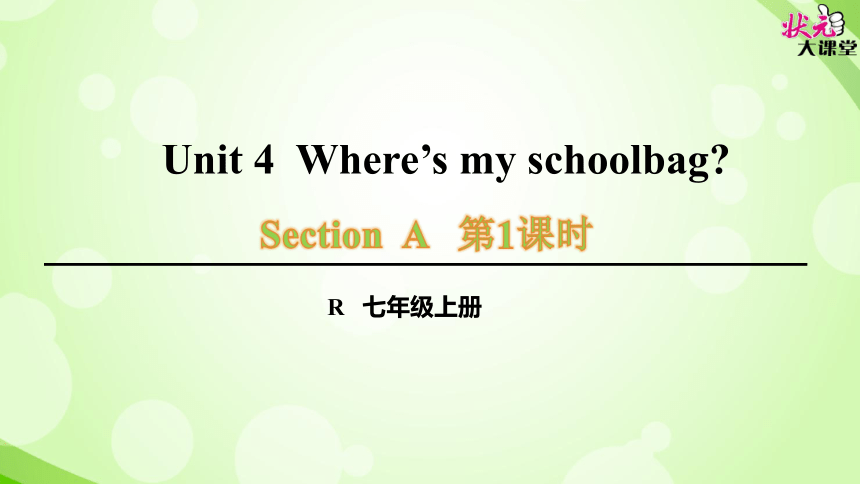 | |
| 格式 | zip | ||
| 文件大小 | 8.7MB | ||
| 资源类型 | 教案 | ||
| 版本资源 | 人教新目标(Go for it)版 | ||
| 科目 | 英语 | ||
| 更新时间 | 2019-08-29 11:36:44 | ||
图片预览

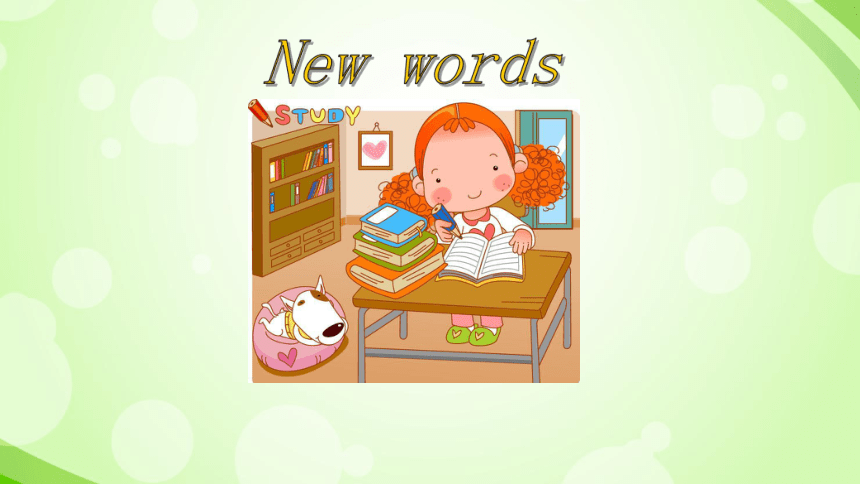


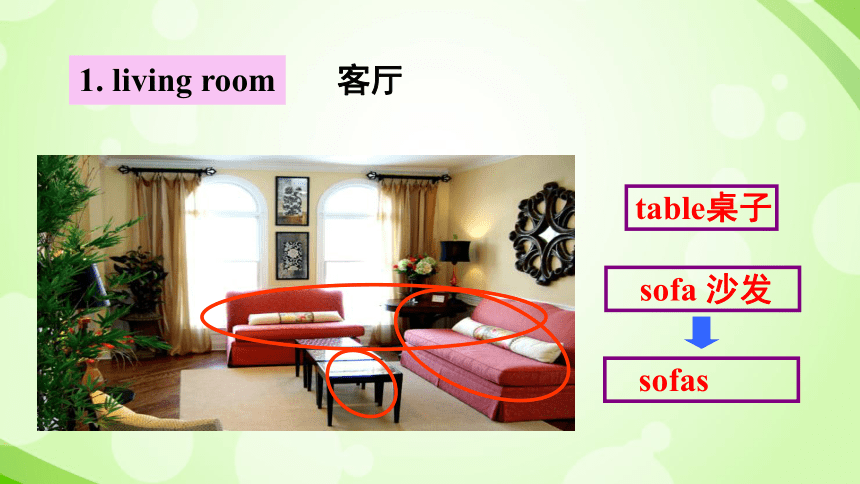

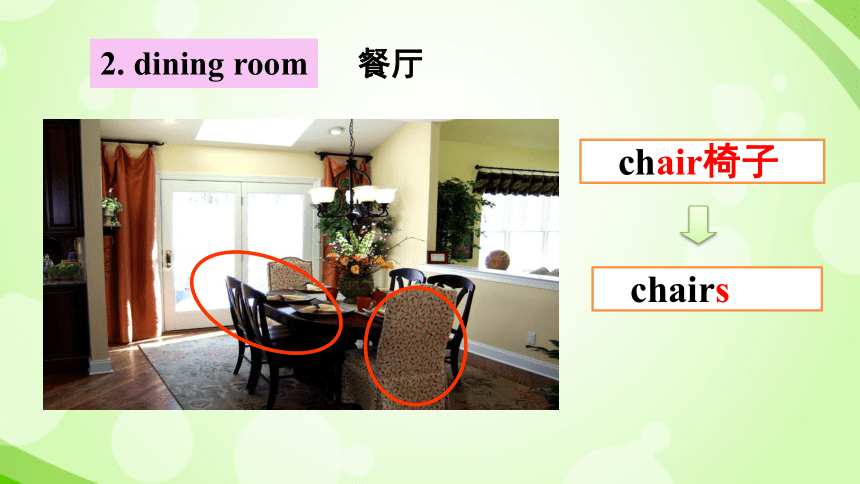
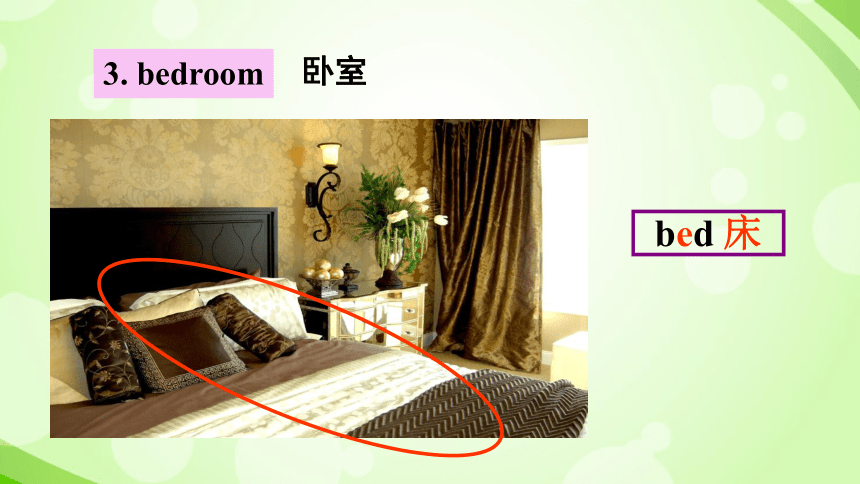
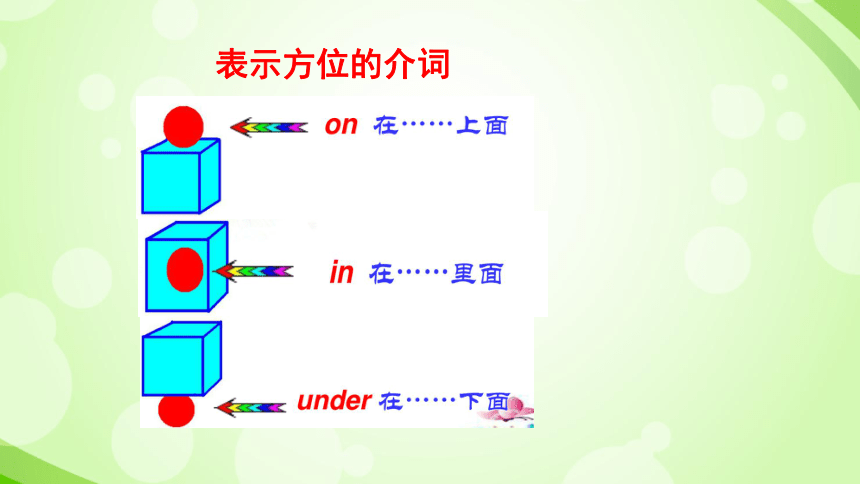
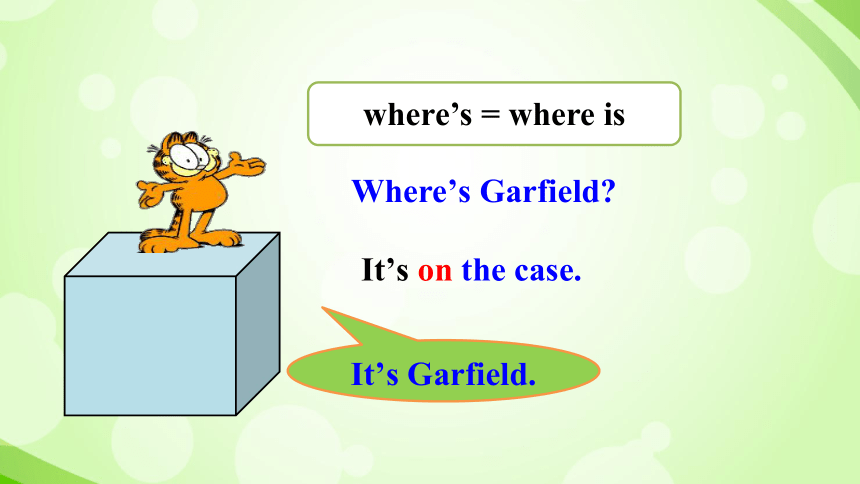
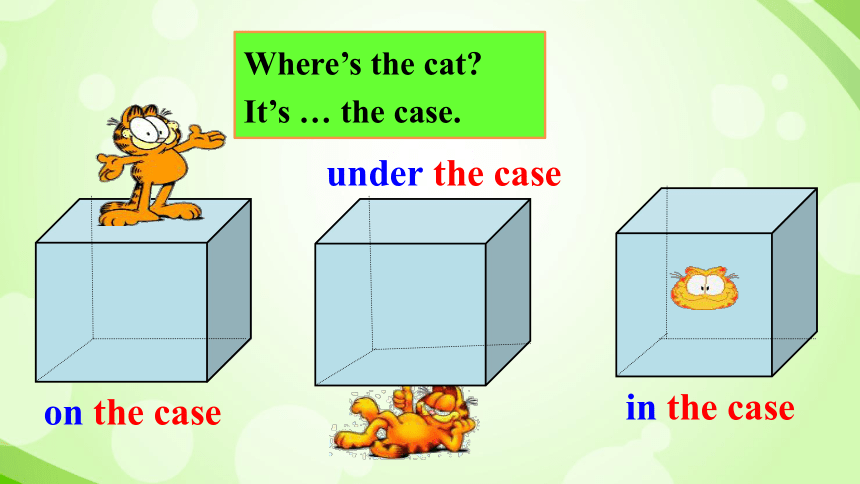
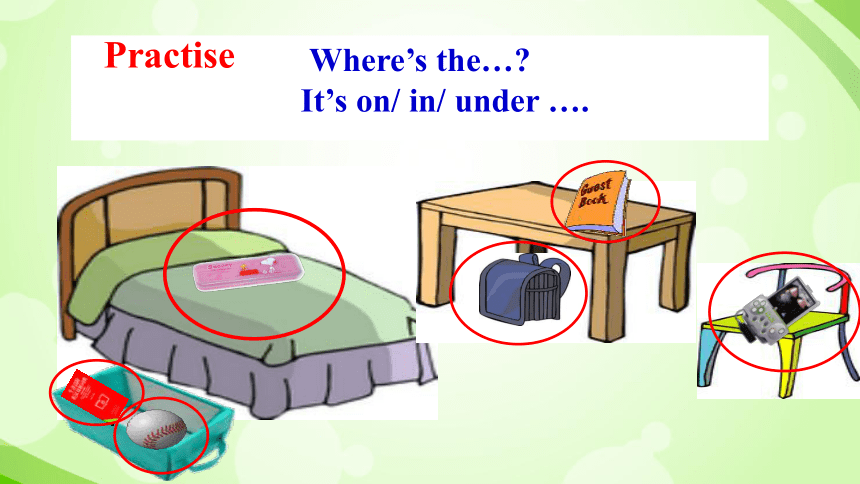
文档简介
课件46张PPT。Unit 4 Where’s my schoolbag?R 七年级上册Section A 第1课时 New wordsNew words where adv.
table n.
bed n.
bookcase n.
sofa n.
chair n.
on prep.
under prep.在哪里;到哪里
桌子
床
书架;书柜
沙发
椅子
在……上
在……下Let's go into the house.GuessWhat’s in this house?Lead-in 1. living roomtable桌子 sofa 沙发 sofas客厅bookcase书架 bookcases 书柜 schoolbag books keys 2. dining room chair椅子 chairs餐厅bed 床3. bedroom卧室表示方位的介词Where’s Garfield? It’s on the case.where’s = where isIt’s Garfield.on the caseunder the case in the caseWhere’s the cat?
It’s … the case.Where’s the…? It’s on/ in/ under ….Practise Language GoalsTalk about where things are—Where are my books??
—They are on the sofa.
—Where’s my pencil box??
—It’s in your schoolbag.
—Where’s my computer game??
—It’s under your bed.1. table ____
2. bed ____
3. bookcase ___
4. sofa ___
5. chair ___
6.schoolbag ___
7. books ___
8. keys ____behgdafc1. on prep. 在……上
【语境领悟】
*They’re on the sofa.
它们在沙发上。
*It’s in your schoolbag.
它在你的书包里。
*It’s under your bed.
它在你的床底下。Language points【自主归纳】介词on的用法
on是介词, 意为“在……上”, 强调一物在另一物的表面上, 其反义词为under“在……下”。常见的词组有:
on the table/desk在桌子/书桌上
on the chair在椅子上
on the bed在床上on 意为“在......上面”,指一个物体在另一个物体的上面,两个物体相互接触。
如:Mary’s schoolbag is on the big chair. 2. in意为“在......里面”,常指某人或某物在某范围空间里。
如:There’s a desk in my room.3. under意为“在......下面”,指一个物体在
另一个物体的正下方。
如:Two boys are playing
under the tree. 【学以致用】
—Where is the basketball?
—It’s the floor (地板) , ____the bed.
A. on; on B. on; under
C. under; on D. under; under1234on in under A :where’s the schoolbag?
B :it’s under the table.Role-playWhere is the pencil box?It’s in the schoolbag.Language pointsWhere’s the schoolbag? 书包在哪里?
【句型剖析】
(1) 这是由where引导的询问某物或某人在哪里的特殊疑问句, 其结构为: Where +be (is, are) +主语?
(2) 句中的be动词要由主语来确定, 当主语是第三人称单数时
be动词用 (is/are) , 当主语是第二人称或第三人称复数时, be动词用 (is/are) 。isare ——Where + is +单数主语+...?
——It is+地点表语。
——Where + are +复数主语+...?
——They are +地点表语。【归纳拓展】
where引导的特殊疑问句的答语
where引导的特殊疑问句的答语为“主语+be+表示位置关系的介词短语”。
——Where is your basketball?
你的篮球在哪里?
——It’s under the desk. 在书桌下面。方位介词(in, on, under…)+名词【学以致用】
①— is my pen?
—It’s in the pencil box.
A. What B. How C. Who D. Where
②—Where are my shoes?
— .
A. Yes, they are B. Yes, I don’t know
C. They are under the sofa D. It’s on the table 12345653426A: Are the keys on the sofa?
B: No, they aren’t. They’re on the table. Describe the place of the thingsRole-playIs the pencil box
under the sofa?Yes , it is.Are the books
on the sofa?No, they are on
the chair .—— Are the keys on the sofa? 钥匙在沙发上吗?
——No, they aren’t. 是的,它们不在(沙发上)。
(1) they“他(她,它)们”,是主格人称代词,在句中作
主语,指代前面提到的复数的人或物,帮其谓语若用 be
动词时,必须用are。
如:They are my good friends.Language points(2) 在回答用these / those作主语的一般疑问句时,答句的主语要有人称代词they用代替指示代词these或those。
——Are these / those chairs…?
——Yes, they are. / No, they aren’t.Mom: Come on, Jack!
Jack: Oh, no! Where’s my bag?
Mom: Hmm…is it on your desk?
Jack: No. And it’s not under the chair.
Mom: Oh! It’s on the sofa.
Jack: Thank you, Mom. Err…where’s the map?
Mom: I think it’s in your grandparents’ room.
Jack: Yes, it’s on their bed! And my hat?
Mom: It’s on your head!
Jack: Oh, yeah! Haha!Read the conversation again, and answer the following questions.1. Where is Jack’s bag?2. Where is the map?3. Where is Jack’s hat?It is on the sofa.It is on Jack’s grandparents’ bed.It is on his head.Language points1.come on快点儿
【语境领悟】
*Come on, Jack! 快点儿, 杰克!
*Come on, Alice. Don’t be afraid. 来吧, 爱丽丝。别害怕。
*“Come on! Come on! ”the students shouted.
“加油! 加油! ”学生们喊道。
*Come on! I’m not afraid of you. 来吧! 我不怕你。
*Come on! Follow me, please. 来, 请跟我来。【自主归纳】
come on的用法
(1) 用来催促别人快走 (做) , 意为“快点儿”。
(2) 用来表示请求、鼓励、劝说等, 意为“来吧; 行啦”。
(3) 用于体育竞赛等场合鼓励队员, 意为“加油”。
(4) 用于挑战或激怒对方, 意为“来吧; 好吧; 试试吧”。
(5) 用于招呼别人, 意为“来, 过来”。2. think v. 认为; 想; 思考
【语境领悟】
*I think it’s in your grandparents’ room.
我认为它在你(外)祖父母的房间里。
*I don’t think she is your sister.
我认为她不是你的妹妹。【自主归纳】
(1) think动词, 意为“认为; 想; 思考”。I think“我认为”,
表述自己的主观想法或看法, 后边常跟that引导的从句
作宾语, 即宾语从句, 口语中that常常被省略。
(2) 当主语是第一人称 (I, we) , think表示“认为”, 其后
接宾语从句时, 若宾语从句表示否定意义, 在形式上应
该否定前面的主句, 这种现象叫否定转移。【学以致用】
①我认为他是你的朋友。
he is your friend.
②I think Tom is her cousin. (改为否定句)
?I thinkI don’t think Tom is her cousin. Ⅰ. 单项选择
1. — are the bags?
—They are on the floor.
A. Where B. How C. What D. Who
2. —Is the key on the sofa?
— .
A. No, I’m not B. It’s under it
C. No, it’s under it D. Yes, it isn’tExercise 3. Sally’s computer game is the bookcase.
A. in B. under C. at D. for
4. —Are those Bill’s keys?
—No, aren’t.
A. it B. they C. these D. those
5. —Where is the map?
—It’s your room.
A. on; parent’s B. in; parent’s
C. in; parents’ D. on; parents’Ⅱ. 完成句子
1. 他的书包在沙发上。
His schoolbag ______ ____ __________ ________.
2. 我的棒球在椅子下面。
My baseballs .
3. 你的钥匙在书包里吗?
your keys ? is on the sofaare under the chairAre in the schoolbag4. 你的父母在哪里?
your parents?
5. 我的手表在床底下。
My watch . Where areis under the bed
table n.
bed n.
bookcase n.
sofa n.
chair n.
on prep.
under prep.在哪里;到哪里
桌子
床
书架;书柜
沙发
椅子
在……上
在……下Let's go into the house.GuessWhat’s in this house?Lead-in 1. living roomtable桌子 sofa 沙发 sofas客厅bookcase书架 bookcases 书柜 schoolbag books keys 2. dining room chair椅子 chairs餐厅bed 床3. bedroom卧室表示方位的介词Where’s Garfield? It’s on the case.where’s = where isIt’s Garfield.on the caseunder the case in the caseWhere’s the cat?
It’s … the case.Where’s the…? It’s on/ in/ under ….Practise Language GoalsTalk about where things are—Where are my books??
—They are on the sofa.
—Where’s my pencil box??
—It’s in your schoolbag.
—Where’s my computer game??
—It’s under your bed.1. table ____
2. bed ____
3. bookcase ___
4. sofa ___
5. chair ___
6.schoolbag ___
7. books ___
8. keys ____behgdafc1. on prep. 在……上
【语境领悟】
*They’re on the sofa.
它们在沙发上。
*It’s in your schoolbag.
它在你的书包里。
*It’s under your bed.
它在你的床底下。Language points【自主归纳】介词on的用法
on是介词, 意为“在……上”, 强调一物在另一物的表面上, 其反义词为under“在……下”。常见的词组有:
on the table/desk在桌子/书桌上
on the chair在椅子上
on the bed在床上on 意为“在......上面”,指一个物体在另一个物体的上面,两个物体相互接触。
如:Mary’s schoolbag is on the big chair. 2. in意为“在......里面”,常指某人或某物在某范围空间里。
如:There’s a desk in my room.3. under意为“在......下面”,指一个物体在
另一个物体的正下方。
如:Two boys are playing
under the tree. 【学以致用】
—Where is the basketball?
—It’s the floor (地板) , ____the bed.
A. on; on B. on; under
C. under; on D. under; under1234on in under A :where’s the schoolbag?
B :it’s under the table.Role-playWhere is the pencil box?It’s in the schoolbag.Language pointsWhere’s the schoolbag? 书包在哪里?
【句型剖析】
(1) 这是由where引导的询问某物或某人在哪里的特殊疑问句, 其结构为: Where +be (is, are) +主语?
(2) 句中的be动词要由主语来确定, 当主语是第三人称单数时
be动词用 (is/are) , 当主语是第二人称或第三人称复数时, be动词用 (is/are) 。isare ——Where + is +单数主语+...?
——It is+地点表语。
——Where + are +复数主语+...?
——They are +地点表语。【归纳拓展】
where引导的特殊疑问句的答语
where引导的特殊疑问句的答语为“主语+be+表示位置关系的介词短语”。
——Where is your basketball?
你的篮球在哪里?
——It’s under the desk. 在书桌下面。方位介词(in, on, under…)+名词【学以致用】
①— is my pen?
—It’s in the pencil box.
A. What B. How C. Who D. Where
②—Where are my shoes?
— .
A. Yes, they are B. Yes, I don’t know
C. They are under the sofa D. It’s on the table 12345653426A: Are the keys on the sofa?
B: No, they aren’t. They’re on the table. Describe the place of the thingsRole-playIs the pencil box
under the sofa?Yes , it is.Are the books
on the sofa?No, they are on
the chair .—— Are the keys on the sofa? 钥匙在沙发上吗?
——No, they aren’t. 是的,它们不在(沙发上)。
(1) they“他(她,它)们”,是主格人称代词,在句中作
主语,指代前面提到的复数的人或物,帮其谓语若用 be
动词时,必须用are。
如:They are my good friends.Language points(2) 在回答用these / those作主语的一般疑问句时,答句的主语要有人称代词they用代替指示代词these或those。
——Are these / those chairs…?
——Yes, they are. / No, they aren’t.Mom: Come on, Jack!
Jack: Oh, no! Where’s my bag?
Mom: Hmm…is it on your desk?
Jack: No. And it’s not under the chair.
Mom: Oh! It’s on the sofa.
Jack: Thank you, Mom. Err…where’s the map?
Mom: I think it’s in your grandparents’ room.
Jack: Yes, it’s on their bed! And my hat?
Mom: It’s on your head!
Jack: Oh, yeah! Haha!Read the conversation again, and answer the following questions.1. Where is Jack’s bag?2. Where is the map?3. Where is Jack’s hat?It is on the sofa.It is on Jack’s grandparents’ bed.It is on his head.Language points1.come on快点儿
【语境领悟】
*Come on, Jack! 快点儿, 杰克!
*Come on, Alice. Don’t be afraid. 来吧, 爱丽丝。别害怕。
*“Come on! Come on! ”the students shouted.
“加油! 加油! ”学生们喊道。
*Come on! I’m not afraid of you. 来吧! 我不怕你。
*Come on! Follow me, please. 来, 请跟我来。【自主归纳】
come on的用法
(1) 用来催促别人快走 (做) , 意为“快点儿”。
(2) 用来表示请求、鼓励、劝说等, 意为“来吧; 行啦”。
(3) 用于体育竞赛等场合鼓励队员, 意为“加油”。
(4) 用于挑战或激怒对方, 意为“来吧; 好吧; 试试吧”。
(5) 用于招呼别人, 意为“来, 过来”。2. think v. 认为; 想; 思考
【语境领悟】
*I think it’s in your grandparents’ room.
我认为它在你(外)祖父母的房间里。
*I don’t think she is your sister.
我认为她不是你的妹妹。【自主归纳】
(1) think动词, 意为“认为; 想; 思考”。I think“我认为”,
表述自己的主观想法或看法, 后边常跟that引导的从句
作宾语, 即宾语从句, 口语中that常常被省略。
(2) 当主语是第一人称 (I, we) , think表示“认为”, 其后
接宾语从句时, 若宾语从句表示否定意义, 在形式上应
该否定前面的主句, 这种现象叫否定转移。【学以致用】
①我认为他是你的朋友。
he is your friend.
②I think Tom is her cousin. (改为否定句)
?I thinkI don’t think Tom is her cousin. Ⅰ. 单项选择
1. — are the bags?
—They are on the floor.
A. Where B. How C. What D. Who
2. —Is the key on the sofa?
— .
A. No, I’m not B. It’s under it
C. No, it’s under it D. Yes, it isn’tExercise 3. Sally’s computer game is the bookcase.
A. in B. under C. at D. for
4. —Are those Bill’s keys?
—No, aren’t.
A. it B. they C. these D. those
5. —Where is the map?
—It’s your room.
A. on; parent’s B. in; parent’s
C. in; parents’ D. on; parents’Ⅱ. 完成句子
1. 他的书包在沙发上。
His schoolbag ______ ____ __________ ________.
2. 我的棒球在椅子下面。
My baseballs .
3. 你的钥匙在书包里吗?
your keys ? is on the sofaare under the chairAre in the schoolbag4. 你的父母在哪里?
your parents?
5. 我的手表在床底下。
My watch . Where areis under the bed
同课章节目录
- starters 预备篇(2012秋审查)
- Unit 1 Good morning !
- Unit 2 What’s this in English?
- Unit 3 What color is it ?
- Unit 1 My name's Gina.
- Section A
- Section B
- Unit 2 This is my sister.
- Section A
- Section B
- Unit 3 Is this your pencil?
- Section A
- Section B
- Unit 4 Where's my schoolbag?
- Section A
- Section B
- Unit 5 Do you have a soccer ball?
- Section A
- Section B
- Unit 6 Do you like bananas?
- Section A
- Section B
- Unit 7 How much are these socks?
- Section A
- Section B
- Unit 8 When is your birthday?
- Section A
- Section B
- Unit 9 My favorite subject is science.
- Section A
- Section B
